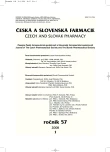Substances Modifying the Activity of Caspases
Authors:
T. Bartl; P. Žádníková; R. Jiříkovská; B. Maroušková; L. Beneš
Authors place of work:
Veterinární a farmaceutická univerzita Brno, Farmaceutická fakulta, Ústav chemických léčiv
Published in the journal:
Čes. slov. Farm., 2008; 57, 29-34
Category:
Původní práce
Summary
Caspases are enzymes which play a key role in programmed cell death – apoptosis. Dysregulation of this process results in a series of disorders in which apoptosis is involved in pathogenesis. Diseases could be divided into two groups – diseases with pathological inhibition of apoptosis (cancer, some autoimmune disorders) and diseases with pathological induction of apoptosis (neurodegenerative disorders, AIDS). The paper lists the most significant activators and inhibitors of caspases as they control apoptosis and hence they are widely studied nowadays. The effects of stobadine, theophylline and adenine derivatives on the activity of caspase 1 was investigated with the use of spectrophotometry. The compounds under study showed an inhibitory effect on the enzyme tested; in one case the inhibitory effect exceeded 80%.
Key words:
caspases – apoptosis – derivatives of stobadine, theophylline, adenine
Zdroje
1. Russell, S. W., Rosenau, W., Lee, J. C.: Am. J. Pathol., 1972; 69, 103–118.
2. Bózner, A., Fízel, A., Kopáčová, L. et al.: Farmakologická propedeutika, 1. vyd. Bratislava, Osveta, 1984; 277, 278.
3. https://www.zdravcentra.cz, staženo 5. 1. 2007.
4. Rosypal, S.: Úvod do molekulární biologie, 1. vyd. Blansko, Grafex, 1999; 485–488.
5. http://www.fnplzen.cz/, staženo 11. 2. 2007.
6. Steller, H.: Science, 1995; 267, 1445–1449.
7. Jacobson, M. D., Weil, M., Raff, M. C.: Cell, 1997; 88, 347–354.
8. Cohen, J. J.: Immunol. Today, 1993; 14, 126–130.
9. Trauth, B. C., Keesey, J.: Cell death. In: Trauth, B. C. Boehringer Mannheim, 1998; 34–61.
10. Rudin, C. M., Thompson, C. B.: Annu. Rev. Med., 1997; 48, 267–281.
11. Riedl, S. J., Shi, Y.: Nat. Rev. Mol. Cell Biol., 2004; 5, 897–907.
12. Li, P., Nijhawan, D., Budihardjo, I. et al.: Cell, 1997; 91, 479–489.
13. Reed, J. C.: Am. J. Pathol., 2000; 157, 1415–1431.
14. Green, D. R., Kroemer, G.: J. Clin. Invest., 2005; 115, 2610–2617.
15. Varfolomeev, E. E., Ashkenazi, A.: Cell, 2004; 116, 491–497.
16. Chinnaiyan, A. M.: Neoplasia, 1999; 1, 5–15.
17. Yan, N., Shi, Y.: Annu. Rev. Cell Dev. Biol., 2005; 21, 35–56.
18. Philchenkov, A.: J. Cell Mol. Med., 2004; 8, 432–444.
19. Ho, P. K., Hawkins, C. J.: FEBS Lett., 2005; 272, 5436–5453.
20. Yuan, J. Y., Shaham, S., Ledoux, S. et al.: Cell, 1993; 75, 641–652.
21. Twomey, C., McCarthy, J. V.: J. Cell Mol. Med., 2005; 9, 345–359.
22. Fan, T. J., Han, L. H., Cong, R. S., Liang, J.: Acta Biochim. Biophys. Sinica, 2005; 37, 719–727.
23. Wolf, B. B., Green, D. R.: J. Biol. Chem., 1999; 274, 20049–20052.
24. Degterev, A., Boyce, M., Yuan, J. Y.: Oncogene, 2003; 22, 8543–8567.
25. Shi, Y.: Mol. Cells, 2002; 9, 459–470.
26. Fuentes-Prior, P., Salvesen, G. S.: Biochem. J., 2004; 384, 201–232.
27. Lavrik, I. N., Golks, A., Krammer, P. H.: J. Clin. Invest., 2005; 115, 2665–2672.
28. http://is.muni.cz/ staženo 9. 2. 2007.
29. Jin, Z. Y., El-Deiry, W. S.: Cancer Biol. Ther., 2005; 4, 139–163.
30. Thompson, C. B.: Science, 1995; 267, 1456–1462.
31. http://ustavpatologie.upol.cz, staženo 15. 2. 2007.
32. Chwajol, B.: Urologie pro praxi, 2001; 3, 119–121.
33. http://www.sukl.cz/, staženo 14. 2. 2007.
34. Hideshima, T., Chauhan, D., Podar, K. et al.: Semin. Oncol., 2001; 28, 607–612.
35. http://www.chem-online.org/generic-pharmaceutical, staženo 19. 2. 2007.
36. Oancea, M., Mani, A., Hussein, M. A., Almasan, A.: Int. J. Hematol., 2004; 80, 224–231.
37. Ückert, S., Hedlund, P., Andersson, K. E. et al.: Eur. Urol., 2006; 50, 1194–1207.
38. Klener, P.: Sanquis, 2004; 36, 14–16.
39. http://redpoll.pharmacy.ualberta.ca, staženo 14. 2. 2007.
40. Graczyk, P. P.: Restor. Neurol. Neurosci., 1999; 14, 1–23.
41. Bonuccelli, U., Del Dotto, P.: Neurology, 2006; 67, 30–38.
42. Loher, F., Bauer, C., Landauer, N. et al.: J. Pharmacol. Exp. Ther., 2004; 308, 583–590.
43. http://merops.sanger.ac.uk, staženo 27. 2. 2007.
44. Concha, N. O., Abdel-Meguid, S. S.: Current Med. Chem., 2002; 9, 713–726.
45. Beneš, L., Pronayová, N.: Pharmazie, 1994; 49, 69–70.
46. Návody firmy Calbiochem: Calbiochem User Protocol, No. 218783.
Štítky
Farmacie FarmakologieČlánek vyšel v časopise
Česká a slovenská farmacie

2008 Číslo 1
- Antibiotika na nachlazení nezabírají! Jak můžeme zpomalit šíření rezistence?
- FDA varuje před selfmonitoringem cukru pomocí chytrých hodinek. Jak je to v Česku?
- Jak si poradit s antibiotiky v magistraliter přípravě
Nejčtenější v tomto čísle
- Signálne dráhy bunkovej proliferácie a smrti ako ciele potenciálnych chemoterapeutík
- Hemostatické účinky oxidované celulosy
- POKROKY V LÉKOVÝCH FORMÁCH – PRACOVNÍ DEN SEKCE TECHNOLOGIE LÉKŮ ČFS JEP
- Látky ovlivňující aktivitu kaspas
